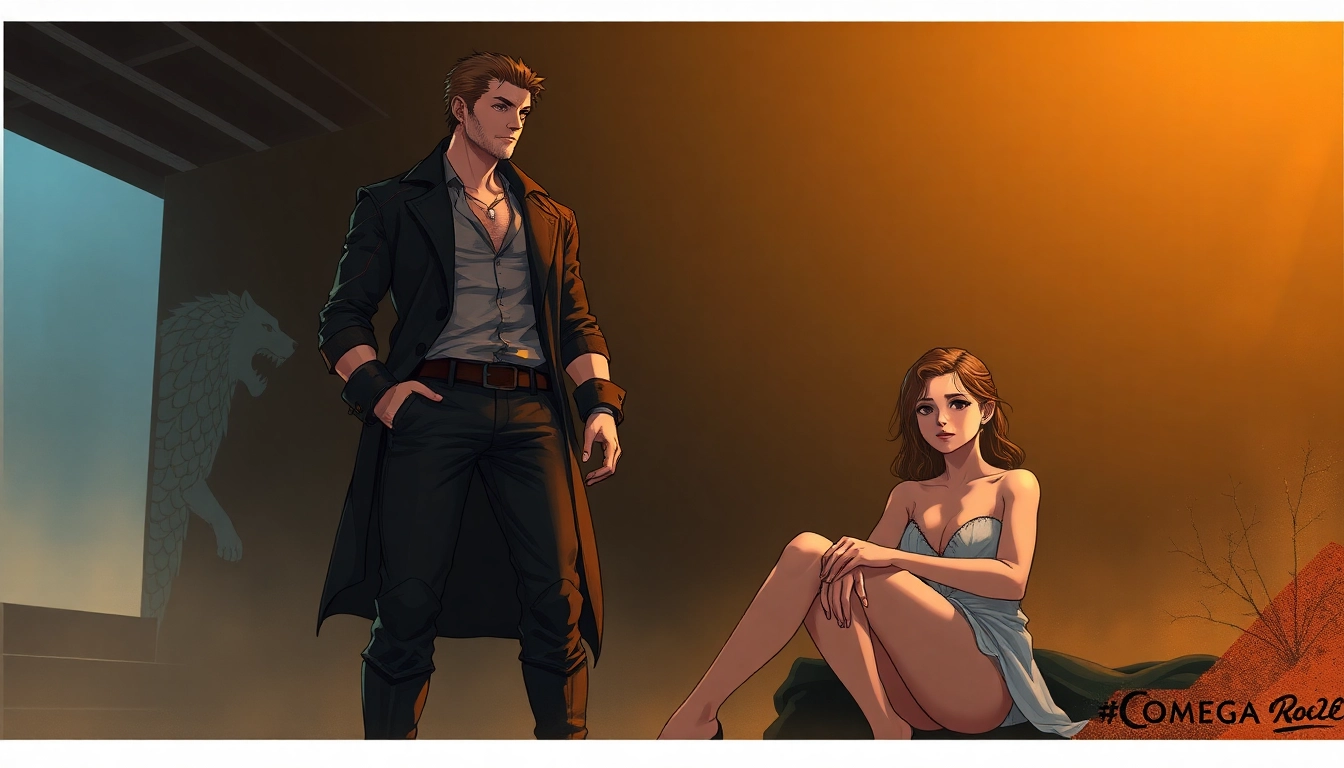The Omegaverse, also known as A/B/O , is a fascinating and complex subgenre that originated within erotic fanfiction communities. It has since expanded into a wide array of original works, blending elements of fantasy, sexuality, societal hierarchy, and character dynamics. The Omegaverse presents a unique universe where human society is structured similarly to a wolf pack, with distinct roles and behaviors assigned to different groups—namely, alphas, betas, and omegas. This hierarchical system influences romantic, sexual, and social interactions, often exploring themes of dominance, submission, and innate biological drives. Understanding the origins and core concepts of the Omegaverse provides insight into its popularity and its profound influence on modern erotic fiction and online communities.
Introduction to the Omegaverse: Origins and Definition
The Omegaverse first emerged in the early 2010s within the fanfiction community, particularly among fans of popular media franchises such as Supernatural, Teen Wolf, and others featuring supernatural or animalistic traits. It quickly gained traction due to its unique blending of eroticism and societal commentary. Originally, Omegaverse stories were written to explore alternative social structures, where characters’ biological roles deeply affected their identities, relationships, and interactions.
At its core, the Omegaverse is a fictional universe that models human relationships after the social and reproductive behaviors observed in canines and other pack animals. The system assigns individuals to specific roles—alpha, beta, or omega—based on biological and sometimes psychological traits. These roles are not fixed by gender alone but are often expressed through a combination of biological features, personality tendencies, and social status. The genre’s primary focus is on the interplay of dominance and submission, often depicted through explicit sexual encounters, romantic tension, and societal expectations.
The Hierarchical Structure: Alphas, Betas, and Omegas
The Alphas: Leaders and Dominants
Alphas are typically portrayed as the most dominant and influential members of the hierarchy. They often possess physical strength, commanding presence, and a natural air of authority. In many stories, alphas are characterized by their assertiveness, confidence, and protective instincts. They are often depicted as natural leaders, both in social and sexual contexts, and may exhibit traits such as decisiveness, assertiveness, and a commanding voice.
Biologically, alphas are associated with traits like heightened pheromone production, which can influence the behavior of betas and omegas. Their pheromones are often described as intoxicating or irresistible, reinforcing their role as the top of the hierarchy. In romantic or sexual relationships, alphas tend to take the initiative, asserting control and dominance, though they may also display tenderness and protectiveness toward their partners.
The Betas: The Neutral Middle Ground
Betas are considered the most neutral and adaptable group within the Omegaverse hierarchy. They typically do not exhibit the extreme biological or social traits associated with alphas or omegas. Betas often serve as mediators or connectors between the two extremes, functioning as the “everyman” or “everywoman” in many narratives. They might possess average physical attributes, moderate pheromone levels, and flexible social roles.
In terms of personality, betas are often depicted as pragmatic, balanced, and less driven by primal instincts. Their relationships tend to be more egalitarian, and they may find themselves attracted to either alphas or omegas. Because of their neutral status, betas often serve as the audience’s point of view or the perspective character in stories, helping to bridge the gap between the other roles and explore the societal dynamics of the Omegaverse.
The Omegas: Submissives and Reproductively Receptive
Omegas are characterized by their submissive tendencies and biological traits associated with fertility and mating. They are often depicted as more sensitive, nurturing, and emotionally open, but also as highly reproductive and biologically driven to seek mates. Pheromone production in omegas is usually described as alluring or attractive, especially during heat cycles, which can influence the behavior of alphas and betas.
In many stories, omegas undergo heat cycles—periods of heightened fertility and sexual receptivity—during which they may experience intense biological urges. These heat cycles can be a central plot element, often leading to drama, romance, or erotic encounters. Omegas are also frequently portrayed as the most vulnerable to dominance and control, which can be explored both consensually and non-consensually within narrative frameworks.
Themes and Tropes in Omegaverse Fiction
Power Dynamics and Consent
One of the defining themes in Omegaverse stories is the exploration of power and control. These narratives often delve into complex dynamics of dominance and submission, questioning societal norms and personal boundaries. Consent can vary widely—from consensual, mutual exploration of desires to more problematic depictions of coercion and control—raising ethical questions that are actively debated within fandom communities.
Biological Urges and Reproductive Drive
Reproductive biology plays a central role in Omegaverse fiction. Heat cycles in omegas, pheromone influence, and biological imperatives often drive the plot. These elements serve as metaphors for primal instincts, highlighting themes of sexuality, desire, and societal roles. The biological aspect adds layers of complexity, as characters navigate their innate drives alongside their personal morals and societal expectations.
Romance and Erotic Tension
Romantic relationships in the Omegaverse are often characterized by intense emotional and physical tension. The hierarchical roles create natural conflicts and attractions, with alphas often depicted as protectors or possessors, and omegas as the sought-after mates or vulnerable partners. Erotic tropes such as mating bonds, heat cycles, and pheromone attraction are common, emphasizing the sensual and taboo elements of the genre.
Taboos and Fetishization
As an erotic subgenre, the Omegaverse often explores taboo topics, including non-traditional relationship dynamics, power imbalances, and sometimes non-consensual scenarios. The genre’s portrayal of biological determinism can lead to controversial representations, raising questions about consent, agency, and ethical boundaries. Fans and creators grapple with these themes, often engaging in discussions about ethical storytelling and the impact of these tropes.
Cultural and Social Implications of the Omegaverse
Gender and Societal Roles
The Omegaverse’s hierarchical model prompts reflection on gender roles and societal expectations. It challenges traditional binaries by emphasizing biological and psychological traits over gender identity alone. For example, a female omega might exhibit submissive traits, but her role is also influenced by societal perceptions of femininity and reproductive capacity. Similarly, alpha characters often embody traits associated with leadership and dominance, regardless of gender.
Power, Identity, and Agency
These stories often explore themes of personal agency within a rigid hierarchy. Characters may struggle to assert their autonomy against biological drives or societal pressures, leading to narratives about self-discovery, resistance, and acceptance. The genre can serve as a metaphor for real-world issues related to power dynamics, gender identity, and social inequality.
Impact on LGBTQ+ and Queer Communities
The Omegaverse has become a significant part of queer and LGBTQ+ fandoms because it provides a space to explore alternative relationship structures and gender expressions. Its fluidity allows for diverse representations, including same-sex pairings, non-binary characters, and non-traditional roles. However, its portrayal of sexuality and hierarchy also raises concerns about fetishization and the reinforcement of certain stereotypes, prompting ongoing discussions about representation and authenticity.
The Role of AI and Digital Communities in Omegaverse Fandom
Online Platforms and Fanfiction Communities
The rise of digital platforms like Archive of Our Own , Wattpad, and various Discord servers has fueled the growth of Omegaverse fandom. These communities allow fans to share stories, art, and discussions about the genre, fostering a vibrant and diverse ecosystem. AI-driven tools, such as Crushon.ai and similar AI chatbots, are increasingly used to generate, analyze, and customize fanfic content, helping writers develop plots, characters, and dialogue that align with their creative visions.
AI Chatbots and Creative Assistance
AI companions like Crushon.ai serve as creative partners for fans and writers, offering uncensored and unfiltered assistance in crafting Omegaverse stories. These tools can simulate character interactions, suggest plot twists, and help explore complex hierarchical dynamics. Such AI-driven support democratizes content creation, making it accessible to newcomers and seasoned writers alike, while also enabling more personalized and nuanced storytelling.
Uncensored and Unfiltered Content Generation
One of the unique features of AI chatbots in this space is their ability to produce uncensored and unfiltered content, which appeals to fans seeking more explicit or taboo explorations of the genre. This capability raises ethical considerations regarding responsible AI use, consent, and the depiction of sensitive themes. Nonetheless, it exemplifies how technology is shaping the future of fan-driven narratives within the Omegaverse community.
How Omegaverse Influences Modern Erotic Fiction
Integration into Mainstream Media
While originally confined to fanfiction, elements of the Omegaverse have begun to permeate mainstream media and published works. Some authors incorporate hierarchical dynamics, biological determinism, or societal commentary inspired by the genre into their original fiction. This cross-over signifies the genre’s expanding influence and its capacity to challenge conventional narratives about gender and sexuality.
Innovative Storytelling and Genre Blending
Modern authors and creators are experimenting with blending Omegaverse themes with other genres such as fantasy, science fiction, and horror. This innovation broadens the scope of the genre, allowing for more complex worlds and character arcs. For example, integrating Omegaverse dynamics into dystopian settings or futuristic societies can explore themes of control, rebellion, and survival beyond traditional romantic contexts.
Market and Audience Expansion
The genre’s adaptability has led to a growing audience that extends beyond niche fan communities. Commercial publishers and independent authors are recognizing the genre’s potential, leading to the publication of Omegaverse-inspired novels and anthologies. This expansion fosters diversity in representation and storytelling, reaching readers interested in both erotic and speculative fiction.
Controversies and Ethical Considerations in Omegaverse Content
Fetishization and Stereotyping
One of the main criticisms of the Omegaverse involves its potential to fetishize certain traits, reinforce stereotypes, or promote problematic tropes. Critics argue that the genre can depict non-consensual scenarios or portray hierarchies that mirror oppressive social structures. Fans and creators are encouraged to approach storytelling ethically, emphasizing consent, agency, and respectful representation.
Consent and Power Imbalances
Given the genre’s focus on dominance and submission, ethical storytelling must address issues of consent. Writers are urged to portray healthy relationships, clear boundaries, and mutual respect, especially when exploring sensitive themes like coercion or non-consent. This is particularly important in fanfiction communities, where the line between fantasy and reality can sometimes blur.
Representation and Diversity
Ensuring diverse and authentic representation remains an ongoing challenge. The genre must evolve to include varied gender identities, sexual orientations, and cultural backgrounds, moving beyond stereotypical or monolithic portrayals. Responsible storytelling can help mitigate harmful stereotypes and enrich the genre’s cultural relevance.
Future Trends: The Evolving Landscape of Omegaverse Stories and Media
Emerging Technologies and Interactive Media
Advancements in AI, virtual reality, and interactive storytelling are opening new avenues for Omegaverse narratives. AI-driven role-playing games, immersive VR experiences, and interactive fanfiction platforms can offer personalized and dynamic explorations of hierarchical dynamics, attraction, and societal roles.
Community-Driven Content and Ethical Innovation
As the community continues to grow, there is a push toward creating content that balances creative freedom with ethical responsibility. Initiatives promoting consent, diversity, and mental health awareness are gaining traction, fostering a more inclusive and respectful fandom environment.
Integration into Mainstream Culture
Finally, the influence of the Omegaverse is likely to expand into mainstream literature, television, and film—either directly or through inspired themes. This evolution will challenge audiences to reconsider gender roles, biological determinism, and societal hierarchy, prompting broader conversations about human nature and societal constructs.
Conclusion
The Omegaverse represents a compelling intersection of fantasy, sexuality, and societal exploration. Its hierarchical framework of alphas, betas, and omegas provides rich material for storytelling, allowing creators and fans to probe themes of power, desire, and identity. As technology, community engagement, and cultural awareness evolve, the Omegaverse will continue to influence and reshape modern erotic fiction and beyond. Its capacity to challenge norms, foster diverse representations, and inspire innovative narratives ensures its relevance for years to come. Whether as a niche fandom phenomenon or a burgeoning genre in mainstream media, the Omegaverse remains a fascinating subject for exploration and creativity.




